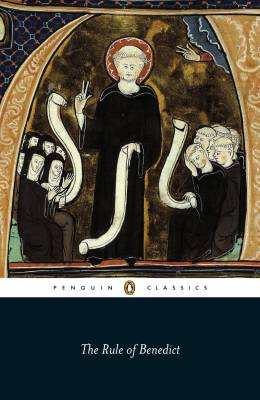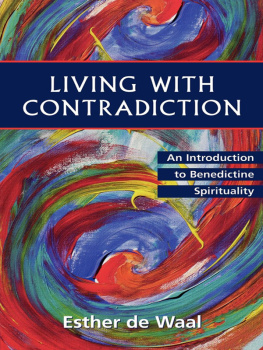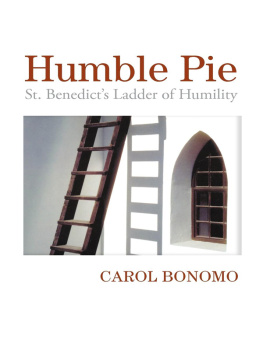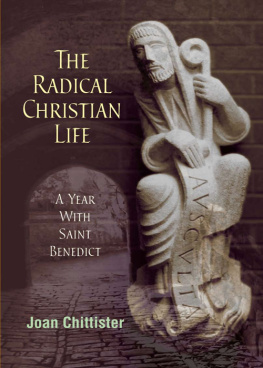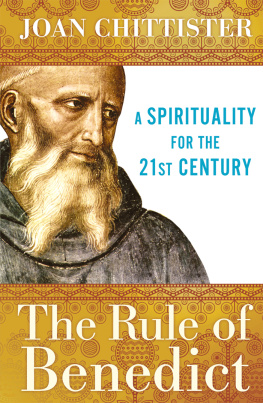
THE RULE OF BENEDICT
BENEDICT, the author of the monastic Rule that bears his name, is known to us only through the account of his life given by Pope Gregory the Great in the second book of his Dialogues, written about fifty years after Benedicts death, in which he is portrayed as a great ascetic and miracle worker rather than as the founder of what was to become, over the following centuries, a hugely successful and influential Christian monastic order. From Gregory we learn that Benedict was born in Nursia (now Norcia), some one hundred kilometres north-east of Rome, in about 480 and was sent to Rome for a classical education. However, he became disillusioned with the decadent life-style he encountered in the capital and withdrew to a place of solitude to dedicate his life to God. As his fame spread, he attracted followers whom he organized into small communities of monks before founding the larger monastery at Monte Cassino between Rome and Naples where he spent the rest of his life and where he wrote the Rule for his monks. He died in about 545.
CAROLINNE WHITE was born in London and read Classics and Modern Languages at St Hughs College, Oxford. She wrote a doctoral thesis on Christian ideas of friendship in the fourth century, published in 1992. After two years spent teaching Latin at the University of South Africa in Pretoria, she returned to Oxford where she worked on the supplement to the Liddell and Scott Greek Lexicon and taught Patristic and Medieval Latin. She now divides her time between work as an assistant editor on the Dictionary of Medieval Latin from British Sources, translation work and her four children. Her publications include a translation of the correspondence between Jerome and Augustine (1990), Early Christian Lives (Penguin, 1998) and an anthology of Early Christian Latin Poets in translation (2000).
The Rule of Benedict
Translated with an Introduction and Notes by
CAROLINNE WHITE
PENGUIN BOOKS
PENGUIN CLASSICS
Published by the Penguin Group
Penguin Books Ltd, 80 Strand, London WC2R 0RL, England
Penguin Group (USA) Inc., 375 Hudson Street, New York, New York 10014, USA
Penguin Group (Canada), 90 Eglinton Avenue East, Suite 700, Toronto, Ontario, Canada M4P 2Y3 (a division of Pearson Penguin Canada Inc.)
Penguin Ireland, 25 St Stephens Green, Dublin 2, Ireland (a division of Penguin Books Ltd)
Penguin Group (Australia), 250 Camberwell Road, Camberwell, Victoria 3124, Australia (a division of Pearson Australia Group Pty Ltd)
Penguin Books India Pvt Ltd, 11 Community Centre, Panchsheel Park, New Delhi 110 017, India
Penguin Group (NZ), 67 Apollo Drive, Rosedale, North Shore 0632, New Zealand (a division of Pearson New Zealand Ltd)
Penguin Books (South Africa) (Pty) Ltd, 24 Sturdee Avenue, Rosebank, Johannesburg 2196, South Africa
Penguin Books Ltd, Registered Offices: 80 Strand, London WC2R 0RL, England
www.penguin.com
This translation published in Penguin Classics 2008
1
Editorial material and translation copyright Carolinne White, 2008
All rights reserved
The moral right of the translator and editor have been asserted
Except in the United States of America, this book is sold subject
to the condition that it shall not, by way of trade or otherwise, be lent,
re-sold, hired out, or otherwise circulated without the publishers
prior consent in any form of binding or cover other than that in
which it is published and without a similar condition including this
condition being imposed on the subsequent purchaser
EISBN: 9780141902951
Contents
Introduction
The Rule of Benedict: characteristics and content
The Rule of Benedict, composed in Latin to the rest of the population is far lower than in the Middle Ages, the legacy of that culture is still strong and Benedictine spirituality, drawing on the Rule, continues to help many, even those outside such communities, by giving them insight into their faith and into the human soul, while also offering a structure to the daily Christian life.
In the Prologue Benedict speaks of his intention to create a school for the Lords service, in which those who have listened to Gods call to follow him and to seek his heavenly kingdom will strive to make progress by means of a combination of good ) would appear to be equally valid outside the monastic context, and yet throughout the Rule he takes for granted not only that what motivates the committed Christian is the desire for eternal life but also that the monastery provides the best conditions in which to work towards fulfilment of this desire.
The routine Benedict proposes for his school revolves round the seven daily services (also known as offices or canonical hours), called Lauds, Prime, Terce, Sext, None, Vespers and Compline,. The abbot should give the strong members of the community something to strive for, while not demanding so much from the weaker ones that they become discouraged.
Although Benedict believes that if the abbot is chosen for the goodness of his life and the wisdom of his teaching, and if he does everything in accordance with Christs teachings, and so they plotted to murder him. However, when they poisoned his wine, Benedict was saved by the miraculous shattering of the wine glass before he could take a sip.
This chilling incident is recounted by Pope Gregory the Great, who wrote an account of the miracles associated with Benedict between Rome and Naples, where he wrote the Rule and where he died in about 545.
In Gregorys Dialogues Benedict comes across as austere but kindly, as we see him using his gifts of healing and prophecy in a calm and unsensational manner, whether in dealing with the celebrities and powerful people of his age who came to visit him, or with the local country people, in this period of political turbulence after the break-up of the Roman Empire when emperor Justinian was struggling to wrest Italy from the control of the Goths. Gregory praises him not only for the miracles which made him famous throughout the world but also for the wisdom of his teaching and for the Rule which is remarkable for its discretion and the clarity of its language.
How central a place did love hold in Benedicts vision? Certainly, he takes the twofold commandment to love God and neighbour, the importance of which was stressed by Christ, for Benedict it is as if the monastery happens to be a community merely as a result of being a kind of boarding school. But for him obedience and love are not contradictory but inextricably linked.
This is evident also in the chapters of the Rule dealing with discipline and punishment. then he will have to be expelled from the monastery. No doubt it was hoped that adult monks could mostly be corrected by means of a discreet rebuke.
As for the boys,them, and a candle is to be kept burning through the night; if they are hungry they are allowed to eat before the others, though they will be given smaller portions than the adults.
As with the relation between love and obedience, so with the relation between the Gospels and the rest of the Bible. Although the Rule is often described as an epitome of Gospel teaching and it is true that Chapter the subject of humility, he warns the monks that God can see into their hearts and knows all their thoughts: he proceeds to quote phrases from five psalms expressing this in different ways, in order to inspire them with fear of God. Later in the same chapter Benedict encourages the monks to persevere through the difficulties of monastic life, giving eight quotations (from the Psalms and St Pauls letters, together with one from the Gospel of St Matthew) to illustrate the truth that hardships are to be expected but that God will also provide support.

